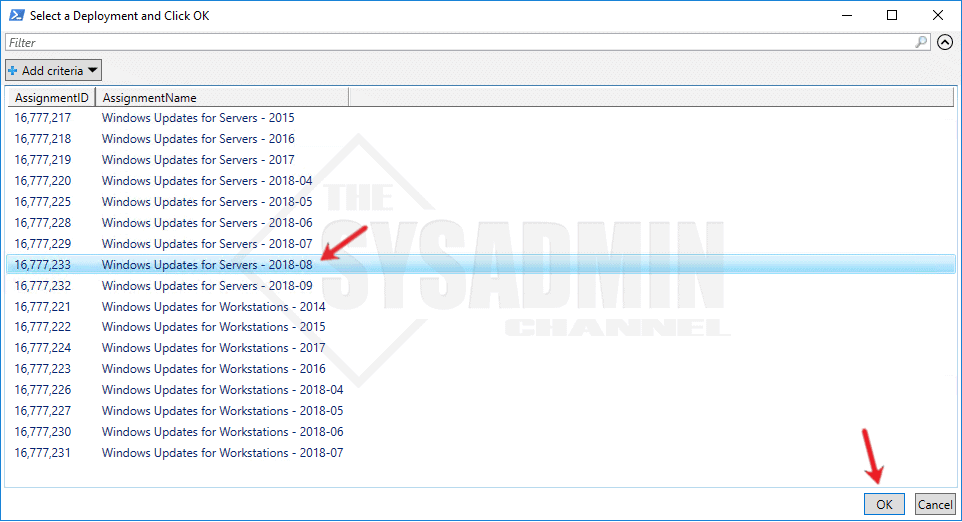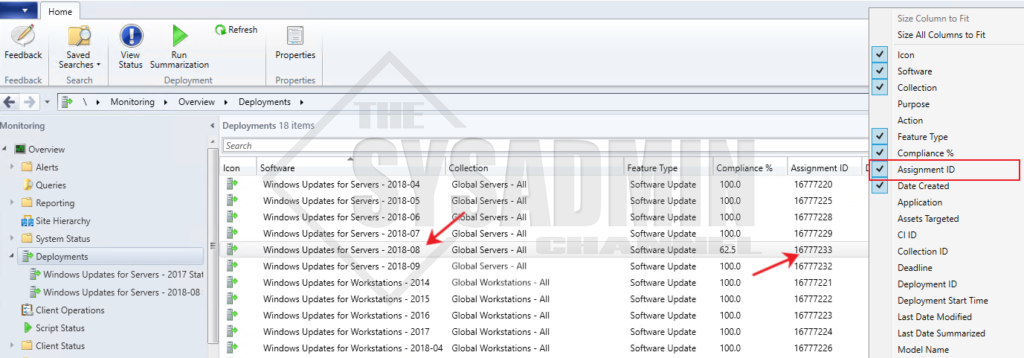I created an SCCM Software Update Status script because very recently I wanted to check the status of my Software Update Deployments within SCCM and quickly found out that there was no easy way of exporting the data I needed. For example, I wanted to export all of the computers that were in progress or pending a reboot so I can run another script and possibly reboot them during off hours. I also wanted to check to see which computers had errors or failed updates so I can quickly run a remote scan cycle and see if that remediates the problem.
I was able to identify the problem, now it was time to create a solution. So with a little bit of Google searching and some knowledge from ol’ trusty Learn Powershell In a Month Of Lunches Book I was able to create Get-SCCMSoftwareUpdateStatus.ps1
Script Requirements
If you’re using the DeploymentIDFromGUI parameter you will need to have the SCCM Configuration Module installed on your computer. Otherwise, this script uses WMI to gather the data. If you’re running the script remotely, you will need to have access to the SCCM server, although that should be a given.
Script Parameters
- DeploymentIDFromGUI: A grid view of your current Software Update deployments will pop up. Select the update you want to query and click OK.
- DeploymentID: Manually enter in a DeploymentID. To get the DeploymentID, go to Monitoring -> Deployments -> Right Click the column header and select AssignmentID
- Status: This parameter allows you to filter by status. Only Success, InProgress, Error and Unknown are valid.
Get SCCM Software Update Status Powershell Script
function Get-SCCMSoftwareUpdateStatus {
<#
.Synopsis
This will output the device status for the Software Update Deployments within SCCM.
For updated help and examples refer to -Online version.
.DESCRIPTION
This will output the device status for the Software Update Deployments within SCCM.
For updated help and examples refer to -Online version.
.NOTES
Name: Get-SCCMSoftwareUpdateStatus
Author: The Sysadmin Channel
Version: 1.0
DateCreated: 2018-Nov-10
DateUpdated: 2018-Nov-10
.LINK
https://thesysadminchannel.com/get-sccm-software-update-status-powershell -
.EXAMPLE
For updated help and examples refer to -Online version.
#>
[CmdletBinding()]
param(
[Parameter()]
[switch] $DeploymentIDFromGUI,
[Parameter(Mandatory = $false)]
[Alias('ID', 'AssignmentID')]
[string] $DeploymentID,
[Parameter(Mandatory = $false)]
[ValidateSet('Success', 'InProgress', 'Error', 'Unknown')]
[Alias('Filter')]
[string] $Status
)
BEGIN {
$Site_Code = 'PAC'
$Site_Server = 'PAC-SCCM01'
$HasErrors = $False
if ($Status -eq 'Success') {
$StatusType = 1
}
if ($Status -eq 'InProgress') {
$StatusType = 2
}
if ($Status -eq 'Unknown') {
$StatusType = 4
}
if ($Status -eq 'Error') {
$StatusType = 5
}
}
PROCESS {
try {
if ($DeploymentID -and $DeploymentIDFromGUI) {
Write-Error "Select the DeploymentIDFromGUI or DeploymentID Parameter. Not Both"
$HasErrors = $True
throw
}
if ($DeploymentIDFromGUI) {
$ShellLocation = Get-Location
Import-Module (Join-Path $(Split-Path $env:SMS_ADMIN_UI_PATH) ConfigurationManager.psd1)
#Checking to see if module has been imported. If not abort.
if (Get-Module ConfigurationManager) {
Set-Location "$($Site_Code):\"
$DeploymentID = Get-CMSoftwareUpdateDeployment | select AssignmentID, AssignmentName | Out-GridView -OutputMode Single -Title "Select a Deployment and Click OK" | Select -ExpandProperty AssignmentID
Set-Location $ShellLocation
} else {
Write-Error "The SCCM Module wasn't imported successfully. Aborting."
$HasErrors = $True
throw
}
}
if ($DeploymentID) {
$DeploymentNameWithID = Get-WMIObject -ComputerName $Site_Server -Namespace root\sms\site_$Site_Code -class SMS_SUMDeploymentAssetDetails -Filter "AssignmentID = $DeploymentID" | select AssignmentID, AssignmentName
$DeploymentName = $DeploymentNameWithID.AssignmentName | select -Unique
} else {
Write-Error "A Deployment ID was not specified. Aborting."
$HasErrors = $True
throw
}
if ($Status) {
$Output = Get-WMIObject -ComputerName $Site_Server -Namespace root\sms\site_$Site_Code -class SMS_SUMDeploymentAssetDetails -Filter "AssignmentID = $DeploymentID and StatusType = $StatusType" | `
select DeviceName, CollectionName, @{Name = 'StatusTime'; Expression = {$_.ConvertToDateTime($_.StatusTime) }}, @{Name = 'Status' ; Expression = {if ($_.StatusType -eq 1) {'Success'} elseif ($_.StatusType -eq 2) {'InProgress'} elseif ($_.StatusType -eq 5) {'Error'} elseif ($_.StatusType -eq 4) {'Unknown'} }}
} else {
$Output = Get-WMIObject -ComputerName $Site_Server -Namespace root\sms\site_$Site_Code -class SMS_SUMDeploymentAssetDetails -Filter "AssignmentID = $DeploymentID" | `
select DeviceName, CollectionName, @{Name = 'StatusTime'; Expression = {$_.ConvertToDateTime($_.StatusTime) }}, @{Name = 'Status' ; Expression = {if ($_.StatusType -eq 1) {'Success'} elseif ($_.StatusType -eq 2) {'InProgress'} elseif ($_.StatusType -eq 5) {'Error'} elseif ($_.StatusType -eq 4) {'Unknown'} }}
}
if (-not $Output) {
Write-Error "A Deployment with ID: $($DeploymentID) is not valid. Aborting"
$HasErrors = $True
throw
}
} catch {
} finally {
if (($HasErrors -eq $false) -and ($Output)) {
Write-Output ""
Write-Output "Deployment Name: $DeploymentName"
Write-Output "Deployment ID: $DeploymentID"
Write-Output ""
Write-Output $Output | Sort-Object Status
}
}
}
END {}
}
SCCM Software Update Status Video Demo
Finally, If this article helped you out, feel free to subscribe to our Youtube Channel for more awesome sysadmin content. If you want to further your SCCM knowledge, be sure to check out our recommended SCCM books:
System Center Configuration Manager Current Branch Unleashed
Learn SCCM in a Month of Lunches Book





Frustratingly Im getting “Unexpected token ‘-DeploymentIDFromGUI'” every time.
Thank you.